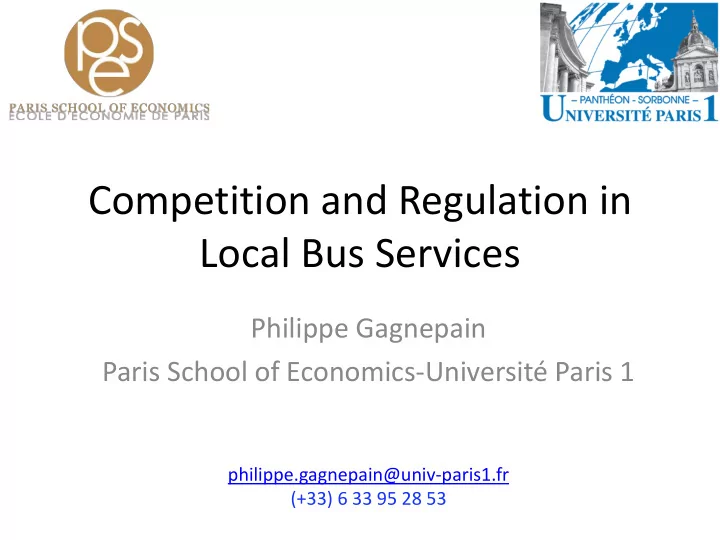

Competition and Regulation in Local Bus Services Philippe Gagnepain Paris School of Economics-Université Paris 1 philippe.gagnepain@univ-paris1.fr (+33) 6 33 95 28 53
Overview Academic research perspective. Competition on the road: UK – Industry not contestable. – Capacity competition. Competition for the market: France – Risks of collusion among bidders. Regulation and incentives: France – Political capture.
Competition on the road: Entry is unsuccessful The industry is not perfectly contestable – Beesley (1990), Evans (1991), Banister (1997), De Borger and Kerstens (2006), Langridge and Sealey (2000), van der Veer (2002), and Wand and Yang (2005). – Existence of barriers to entry: Access to bus stations , use of travel cards, convenient terminal positions, access to bus stations, information points. – Sunk costs: trained staff, rolling stock. – Economies of experience, scale, density, and scope. – Incumbent can reduce prices very quickly or runs more buses and increases the frequency of the service.
Competition on the road: In price or frequency – Wang and Yang (2005), and Van Reeven and Janssen (2006). – Two firms with distinct qualities of service and different fares. Not relevant – Competition takes the form of service wars with fare matching. – Consumers do not care for quality and board the first bus that arrives. – Frequency is the key factor for competition.
Competition on the road: Random schedules – Ellis and Silva (1998), Oldale (1998), Van Reeven and Janssen (2006), and Gomez-Lobo (2007). – Incentive to drive in front of each other: Head running and leapfrogging. – Bus operators randomize arrival schedules at the bus stop. – No commitment on timetable information. – Set the highest possible prices.
Competition on the road: A research agenda Most contributions of the economic literature are theoretically derived. Need to be empirically validated. Estimate a cost function to evaluate economies of scale and scope. To detect predatory practices, compare prices to marginal and average costs (Motta, 2004). To test for price competition: – Estimate a structural model, demand function and price equation (Davis and Garces, 2010). – Reduced form: Effect of the # of firms on prices and frequencies. Additional thoughts: Gagnepain, Ivaldi, and Vibes (2011).
Competition for the market: Key issues Urban transportation service concession awarded through a tender. Risk of collusion among bidders: France – In theory, competitive tendering since 1993. Four corporations (Keolis, Connex, Transdev, and Agir). Contract length: 5-6 years on average. Groups committed to geographical areas: Very few changes of operators since 1993. One single bidder in a majority of cases (see decision 05-D-38 of the Conseil de la Concurrence ) – Should the recent Transdev-Veolia merger have been approved? Efficiency gains trough the merger; less competition ex-ante. Gagnepain, Ivaldi, Martimort, Pouyet (2012): Merger Guidelines for Bidding Markets. 7
Competition for the market: Key issues Risk of collusion among bidders: France – Long term relationship over several periods. Contract renegotiation The regulator strategically uses information from one period to another: Cost and/or choice of contract. The operator may shirk to avoid revealing information. Higher welfare if commitment. Ability of the regulator to commit to the same contract over time: Contract length? Gagnepain, Ivaldi, Martimort (2011). 8
Regulation incentives and political capture (Re)Negotiation versus competitive tendering: Cost-plus contracts (ex-post costs fully reimbursed) are still intensively used in France. Choice of contract important issue Incentives to reduce costs. No regulatory agency; politicians. Asym info, unsophisticated. Regulators may favor interest groups and choose one regulatory scheme or another. – Unions versus stakeholders. – Political color of the regulator, preferences of the operator, characteristics of the service. Important consequences on operating and social costs. Gagnepain and Ivaldi (2011), Chong, Staropoli, and Yvrande-Billon (2011) 9
Main lessons… Competition on the road seems limited. Organizing an efficient procedure to promote competition for the market is a complex task. Need for an independent regulatory agency. Benefits? – Reduce asymmetric information. – Avoid costly renegotiation. – Avoid political capture. – Welfare gains are known Cost? philippe.gagnepain@univ-paris1.fr (+33) 6 33 95 28 53 10
Recommend
More recommend